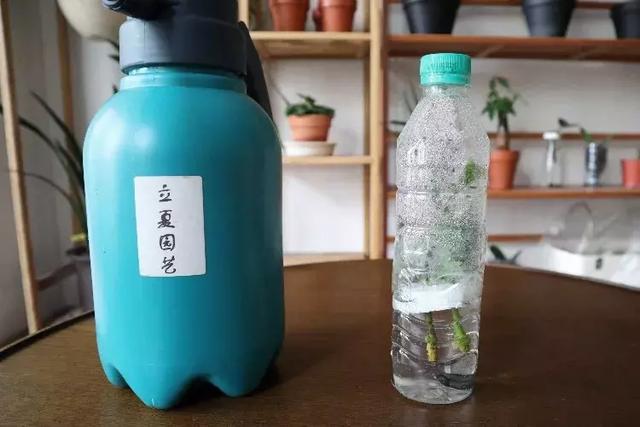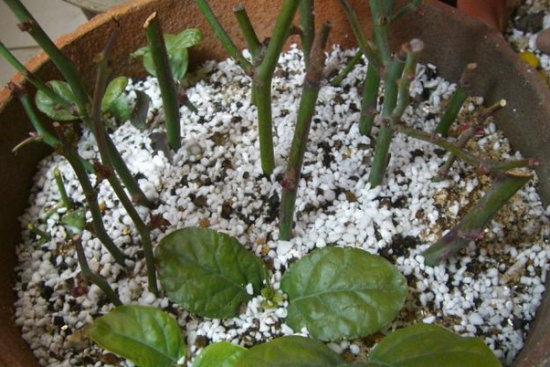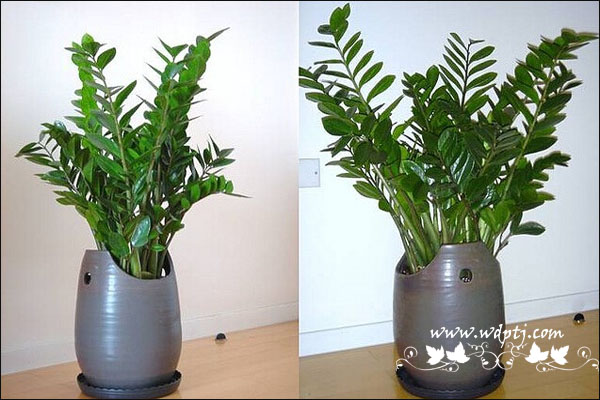Gardenia cut like this, it is very simple and easy to take root!
The gardenia cut by the Beginning of Summer with a mineral water bottle finally took root. It seems to have been used for more than ten days, but I can't remember the details very clearly. Cutting gardenia in this way can generally take root in 1-2 weeks.

About a week or so, I saw a lot of bags bulging on the branches, with very few white spots, which is the rhythm to take root.
In theory, my branches soaked in naphthylacetic acid should be able to take root in a week, but I forgot to watch the weather forecast. After the cuttings went down, the temperature soon dropped, and I had to wear two clothes even as low as ten degrees.
If the temperature is kept at about 25 ℃, the rooting will be much faster, so the most suitable cutting time for most flowers is from May to June, because the temperature is higher and the branches take root faster.
Looking at the picture above, have you noticed that the root of one branch has grown very long, while the other branch is only a little bit? This is the difference between current-year and second-year branches. It is suggested that novice florists try to choose branches that are annual, semi-lignified, sturdy and with shorter stems and nodes.
The specific method of cutting gardenia with mineral water bottle, please watch the previous video: only need a mineral water bottle, you can cut out a pot of gardenia! Next, the Beginning of Summer will continue to use this method to cut rose, camellia, rhododendron, triangular plum, hydrangea and so on. Would you like to see it?
A brief introduction to the Cuttage Propagation of Gardenia jasminoides
Earlier, we introduced two articles about gardenia.
Brief introduction of Gardenia jasminoides what does gardenia symbolize
The flowers like to grow in sunny places and like light, so we must pay attention to give sufficient light to the maintenance of gardenia in spring and autumn, otherwise, the growth and development of gardenia will be affected. it is also very disadvantageous to the overwintering of gardenia. But in summer, if the sun is too strong, gardenia needs to be placed in a semi-shady environment. Gardenia is affected by strong sunlight, high temperature and too much Rain Water, which may induce gardenia yellow leaves. If the environmental conditions are not improved in time, it will gradually aggravate and even cause death.
In some places, gardenia is called gardenia jasminoides, which also shows that gardenia likes wet habits. So we must pay attention to the requirements of environmental conditions when potted gardenia.
Gardenia also has the effect of purifying air, and has strong resistance to bad gases such as Ryukyu dioxide, hydrogen fluoride and so on. However, Gardenia jasminoides is sensitive to smoke and weak resistance, so the leaves of Gardenia jasminoides are easy to stick to dust and affect its respiration. Smoke is also one of the causes of poor growth and death. Therefore, in the conservation of gardenia, we must pay attention to the effect of smoke and dust on the growth of gardenia.
Brief introduction of Cuttage Propagation of Gardenia jasminoides
Which propagation method is usually used to propagate gardenia?
Propagation of gardenia generally uses cutting propagation, because gardenia is easy to take root by cutting propagation.
Common cutting propagation methods of gardenia
There are two methods of branch cutting of gardenia, one is soil cutting, the other is water cutting.
Propagation of Gardenia jasminoides in soil
Gardenia flower soil cutting is divided into twigs and old branches. Let's start with the tender wood cuttings of Gardenia jasminoides.
1. The tender wood cuttage is to take the sturdy branches of the same year to carry on the cutting, cut the cuttings used to grow up to 8-15 cm for cutting.
two。 Cutting period must pay attention to, this is the key to survival, it is generally best from the first to the middle of the season, the fastest rooting, the highest survival rate, but the management is also the most fine, to ensure high air humidity and semi-shade state.
3. It can take root 2-3 weeks after cutting, and the survival rate can reach about 90%.
4. Spring cuttings, you can use 1-2-year-old branches, cuttings cut to grow about 20 cm, shade the bed, leaves often spray water to maintain high humidity. The old wood cuttings take root for a long time in spring, and the survival rate is 70-80%, but the old wood cuttings survive and form clumps faster.
5. The basin soil used for cutting is generally the best made of black soil mixed with sand of 1 stroke 2. Because the black soil is acidic, the water retention is strong, and the sand permeability is good for rooting. However, pure sand or vermiculite can also be used as potted soil to grow roots, but they should be transplanted to fertile soil in time after rooting.
5. After cutting, keep enough water to avoid stagnant water. The low temperature of the watering water has a great impact on survival. Do not cause strong changes in bed temperature when watering, so when cutting in summer, watering is before 7-8 o'clock in the morning and after 9-10:00 in the afternoon. Do not use hot water during the day to avoid blackening and decay at the base of the cuttings.
Propagation of Gardenia jasminoides by water insertion
Gardenia water insertion is now more popular, because clean, clean, loved by many people, gardenia water insertion is a method to soak the base of the cuttings in water to take root. Cuttings cut the sturdy twigs that grew that year, cut and grow 12-15 cm, 30-40 branches tied into a bunch, and then soak the cuttings in hot water. Gardenia flower water insertion method is best to change the water once a day. After the water is inserted, the water container is placed in a semi-shaded place. generally speaking, it will take about 20 days for new roots to grow. There is also a more troublesome method, that is, with a thin plank, the plank is drilled into a small hole according to the 2x5 centimeter distance, and each hole is inserted with an insert, and then the plank can be placed on the basin of water, and it should be noted that the gardenia cuttings under the plank are not in the basin water at all. Although this method is a bit troublesome, the effect is better than the method of water insertion in bundles.
Gardenia propagation method, gardenia cutting method, striping method, sowing method
Gardenia grows like one in the four seasons, the leaf color is evergreen, the fragrance is elegant when blooming, and the white flowers are white, which is particularly beautiful and very attractive. It is often used for potted plants in courtyards and balconies. It has strong environmental adaptability, can grow well in these places, and has strong decorative and ornamental effects.
Propagation method of Gardenia jasminoides
1. Cutting method
The branches of Gardenia jasminoides are easy to take root, the warm ground in the south is often in March-October, and the north is often cut in May-June, cutting sturdy mature branches and planting them on the sand bed. As long as they are often kept moist, they are very easy to take root and survive. Water insertion is far better than soil insertion, with a survival rate of nearly 100% from April to July. Cut cuttings retain only the top 2 leaves and terminal buds in containers filled with clear water, often change water to avoid incision decay, and begin to take root after 3 weeks.
2. Strip pressing method
It is generally carried out before and after the Qingming Festival in April or in the Meiyu season. In April, one-year-old strong branches are selected from the 3-year-old mother plant, which are 25cm long and 30cm long. They are pulled to the ground, and the buried parts of the branches are scratched. If they can be dipped in 200ppm powder acetic acid and then covered with soil compaction, it is easier to take root. If there are trigeminal branches, you can get three seedlings at the fork at a time. Generally, it can take root after 20-30 days, can be separated from the mother plant after rooting in June, and can be planted separately with soil or a single plant in the next spring.
Spring is the best way to transplant seedlings or potted plants, and it is necessary to bring soil balls in the rainy season. Keep the soil moist during the growing period, and water more during flowering and midsummer. Fertilize once a month and increase phosphorus and potassium fertilizer before flowering. Pruning and shaping in the early spring of the following year, and cut off dead branches and long branches in time.
3. Sowing method
Generally choose full, dark red ripe fruit, even shell sun or dry as a seed, before sowing, use scissors to cut the seed pericarp, dig out the seed, rub in hot water to disperse, remove floating seeds or impurities, and then remove the sunken full seed, spread it on the bamboo mat, put it in a ventilated place to dry too much moisture. Generally choose Xiangyang hillside or Tufang, the soil layer is deep, loose and fertile sandy loam sowing, you can use the field edge corner planting, or interplanting with legumes. Before planting, plough the land 1 to 1.5 feet, remove miscellaneous trees, set up the border according to the width of 4 to 5 feet (the soil quality is better, the distance can be larger, otherwise it is smaller), the border is 6 inches high, and soil manure, green manure or human and animal manure can be used as base fertilizer, for example, 20,30 piculs of human manure per mu should be applied, and the soil should be raked after the soil is dried to level the border surface. Sow the ditch at a distance of 6 to 7 inches on the border surface, and the ditch is about 1 inch deep to be sown.
Gardenia can be sowed in spring or autumn, generally in spring, spring sowing before and after Rain Water, autumn sowing before and after the Autumn Equinox, seeds mixed with fire ash evenly sown in the sowing ditch, and then cover the flat sowing ditch with fine soil or fiery soil, cover the grass with water, and often keep the soil moist to facilitate seedling emergence, with seeds of 4 kilograms per mu. After emergence, we should pay attention to remove the cover grass in time, weed frequently in the seedling stage, be careful not to hurt the roots of the seedlings, need to dilute human feces and urine after weeding, and can be transplanted after raising seedlings for one year. If the transportation is far away, it is appropriate to use yellow mud slurry root, cover grass to moisturize, plant one plant in each hole, cover soil, compaction, and sprinkle water. After planting, weeding and topdressing is applied once every spring and summer, which can be applied to human and animal manure, barnyard manure, compost, cake fertilizer and so on. Before flowering in summer, it is better to apply fertilizer with more phosphorus and potassium content, and fertilization is generally carried out after weeding and loosening the soil.
4. Seed propagation
The sowing time is divided into spring sowing and autumn sowing, and spring sowing is better. From early February to late February (the Beginning of Spring to Rain Water). Select full, dark red fruit, dig out the seeds, rub them in the water, get the sunken seeds, dry them, mix them with fine soil or plant ash, sow them in the furrow, cover with fine soil, and then cover with straw; remove straw after germination and weed frequently. If the seedlings are too dense, they should be evenly distributed one after another and keep the distance between plants 10-13cm. Seedlings cultivated for 1-2 years, more than 30 cm high, can be planted.
- Prev

How to cuttage and propagate flowers
There are many kinds of flowers suitable for cutting, such as rose, hibiscus, glass Cui, silver star begonia, etc.; leaf cutting mainly includes chrysanthemum, hairy leaf begonia and so on. 1. The soil used for cutting requires good drainage and ventilation. The ambient temperature of cutting flowers should be between 20 and 25 ℃.
- Next

Why is the tree yellow?
Why is the tree yellow? Either it was lack of nutrition or improper watering. This time, Li Xia picked up a money tree with yellow leaves and saw how the former owner raised it to grow it like this. Li Xia has something to say: As far as I know, many flower friends raise flowers, but they don't have the habit of changing pots.
Related
- Fuxing push coffee new agricultural production and marketing class: lack of small-scale processing plants
- Jujube rice field leisure farm deep ploughing Yilan for five years to create a space for organic food and play
- Nongyu Farm-A trial of organic papaya for brave women with advanced technology
- Four points for attention in the prevention and control of diseases and insect pests of edible fungi
- How to add nutrient solution to Edible Fungi
- Is there any good way to control edible fungus mites?
- Open Inoculation Technology of Edible Fungi
- Is there any clever way to use fertilizer for edible fungus in winter?
- What agents are used to kill the pathogens of edible fungi in the mushroom shed?
- Rapid drying of Edible Fungi

